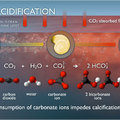
Related Stories
Ocean Acidifica ...
Fundamental changes in seawater chemistry are occurring throu ...
Multi-media
PMEL carbon group frequently works with the media to inform t ...
Sea Grant Interviews with Richard Feely
In 2008 Dr. Richard Feely worked with the Oregon Sea Grant office to produce a few short introductory clips about ocean acidification.
|
|
Ocean Acidification Part 1: What is ocean acidification?
Richard Feely: The process of burning fossil fuels – coal and oil and natural gas -- over the last two hundred years has released about five hundred billion metric tons of CO2 into the atmosphere as carbon. You might think of it this way: We’re releasing right now about seventy million tons of CO2 every day into the atmosphere. And about a third of that, about twenty million tons of CO2, is being absorbed regularly by the oceans. And that ocean uptake then of twenty million tons of CO2 has caused, over the last two hundred years or so, about a 0.1 pH change. pH is a logarithmic scale just like the Richter Scale. So a 0.1 pH change represents about a thirty percent increase in the overall acidity of the oceans. So the oceans has dropped its pH so far from about 8.2 to about 8.1. Using present day scenarios of CO2 emissions, we might expect to see a further pH drop of about 0.3 to 0.4 pH units, which would mean an increase in acidity of another hundred and fifty to two hundred percent. This is a dramatic change in the acidity of the oceans. And it has a serious impact on our ocean eco systems; in particular, it has an impact on any species of calcifying organism that produced a calcium carbonate shell. |
|
|
How will ocean animals be affected?
Richard Feely: And if you go to the beach, of course, what you’ll see are shells from clams and mollusks, and sometimes you’ll see a sand dollar. All these different species form calcium carbonate shells. And they form their shells in a high pH world. And the ability to form their shells, the rate at which they can produce their shells, or even if they can produce their shells, is directly dependent on the changing CO2 levels and the changing pH of seawater. And you can get to the point where they can no longer produce their shells. And we call that the saturation state of seawater. And, there’s been some experiments by scientists that have shown that if they place these organisms, some species of organisms, into this under-saturated water, this corrosive waters, the shells will dissolve, in some cases while the organism is still alive. That’s not true for all organisms. Some organisms have adapted to protect their shells with an organic coating. But as soon as that organisms dies, that organic coating will dissolve away and then the shells dissolve. And we see that in under-saturated waters. Throughout the water column, it’s a normal process in geochemistry. As we add more and more CO2 from the atmosphere to the oceans, this corrosive water is getting closer and closer to the surface, where it comes in contact with out ocean ecosystems. And so all those species that are dependent on the calcium carbonate are susceptible to this dissolution. The coral reefs can no longer produce their skeletons. The basic phytoplankton . . . some species of phytoplankton. . . produce a calcium carbonate shell. They are called a coccolithophorid, and they can no longer produce those shells. Zooplankton, next level up [in the marine food web], the very small animals which are a primary food source for fish: a large portion of zooplankton form these calcium carbonate shells. And as this water gets onto our Continental Shelf, then it affects our major fisheries. It affects all the bottom fisheries, such as clams and oysters and sea urchins and crabs. And it affects the water column, because of these ecosystem changes between the phytoplankton, the zooplankton and the fish. |
|
|
How will ecosystems be affected?
Richard Feely: If they cannot adapt, where will they go? Will they go to waters that have a higher pH and are more supersaturated? If so, what happens to the ecosystem that’s left behind? What happens to the fish that are dependent on these organisms for their food? This is a very serious question. And for coral reef systems in particular, for example, the skeleton of the coral reef system is the major home for twenty-five percent of all our fisheries that live in coral reef systems during some portion of their livelihoods. So it’s a critical component of the ocean ecosystem. On a global basis, about twenty percent of our food resources, in terms of protein, comes directly from fishery sources. So, any changes to the ecosystem will have a direct impact on our food resources from the sea. From the preindustrial to the present, we know that the surface water pH has changed by .1 units; a thirty percent increase in acidity. Over the last thirty years or so, we have been able to specifically measure the changes in pH and the change in CO2 of our surface waters. We do this at the Hawaiian Ocean Time Series off of Hawaii, which is commensurate with the Mauna Loa record in the atmosphere, which is also off the Big Island. We do this off of Bermuda. We do this in a number of locations throughout the world oceans. So our ability to monitor these changes have taken place. You can go back further in the geological record and look at ice core records to see what the impacts of CO2 have been and the changes in CO2 levels in the atmosphere. And what we find is that the atmospheric concentrations, over the last eight hundred thousand years or so, have changed between about a 180 parts per million [of seawater] and 280 parts per million. But we are now as high as 385 parts per million at present. And by the end of this century we could be as high as 800 parts per million. And we can see from the sedimentary record and the ice core records that these changes that are taking place throughout this century, out to the end of the century and into the next century, far exceed anything we have seen over the last twenty million years or so. |



